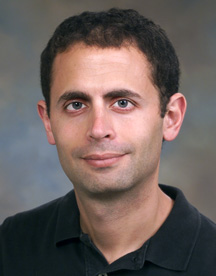

Scripps Research/Pfizer Team Produces a Potential New Painkiller
By Mark Schrope
Scientists from the Scripps Research Institute and Pfizer, Inc. have discovered an exquisitely potent new chemical compound that harnesses the endocannabinoid system—a natural pain-controlling pathway—to deliver profound pain reduction. The compound, called PF-3845, could be pursued as a lead for a drug candidate and should prove an invaluable tool for researchers studying how the endocannabinoid system functions.
The team reports on the promising new compound in the April 24, 2009 issue of the journal Chemistry & Biology.
"PF-3845 is by far the best FAAH inhibitor I've seen," says Professor Benjamin Cravatt, chair of the Scripps Research Department of Chemical Physiology. "Its combination of duration of action and selectivity is unrivaled."
Endocannabinoids activate receptors in the brain that regulate pain, as well as appetite, inflammation, and memory. Researchers have for many years studied the chemical pathways involved in endocannabinoid synthesis and degradation to find new ways to modulate their activity. By modulating the chemical pathway that regulates endocannabinoid levels, it is possible to harness endocannabinoids' positive properties.
The body produces at least two endocannabinoids, and each is regulated through breakdown by a different enzyme.
An enzyme called fatty acid amide hydrolase, or FAAH, which was discovered by the Cravatt lab in the 1990s, controls the activity of one of these endocannabinoids, termed N-arachidonoyl ethanolamine, or anandamide. FAAH breaks down anandamide, so compounds that inhibit FAAH allow the concentrations of this endocannabinoid to increase in the brain, effectively reducing pain without undesirable side effects. As such, there has been great academic and pharmaceutical industry attention focused on FAAH inhibitors.
A Productive Partnership
In 2003, the Cravatt group began collaborating with Pfizer to pursue, among other goals, development of FAAH inhibitors. This collaboration led to the discovery of a promising class of inhibitors known as piperidine ureas, which have proven remarkably specific in their binding with FAAH.
"The trick with these compounds, what makes them so special, is that they are actually very unreactive in general," says Cravatt. "It's only with FAAH that they become reactive, so they derive their exquisite selectivity from this remarkable mechanistic synergy."
The piperidine urea class also proved to be extremely long-lasting because the mechanism by which they inhibit FAAH, preventing the enzyme from breaking down anandamide, is irreversible.
Despite attractive selectivity and stability, the best of the initial discoveries, PF-750, was only moderately potent. So, Pfizer made a significant effort to improve the potency and pharmacokinetic properties without decreasing selectivity, and PF-3845 has emerged with many desirable properties. Professor Raymond Stevens, whose lab at Scripps Research has solved three-dimensional structures relevant to the FAAH work, also joined the collaboration. His lab solved the crystal structure of the PF-3845 in complex with the FAAH enzyme, which is also disclosed in this paper.
Initial experiments have shown PF-3845 to be 10 to 20 times more potent than other FAAH inhibitors, and it reduces inflammatory pain in pre-clinical models.
What compounds Pfizer will choose to pursue as drug candidates is proprietary information, but Cravatt says that PF-3845 should prove to be an invaluable research tool regardless. Because PF-3845 so effectively blocks FAAH activity, the compound will open a number of research possibilities—some for the first time. Its superior pharmacokinetic properties, for instance, will make it possible to reliably study whether or how the effects of FAAH inhibition change over the long term.
Having spent more than a decade studying the endocannabinoid system, Cravatt says it is rewarding to discover a compound that so powerfully controls it. However, he says, the most rewarding side of the work has been the success of the Pfizer partnership. "This is something that never would have been accomplished without such an open and energetic academic-industrial collaboration."
"This has been an exciting and productive partnership from the very beginning and is a great example of harnessing the strengths of academia and industry to positively impact the drug discovery process," say Kay Ahn and Douglas Johnson, who were the Biology and Chemistry leaders of the FAAH project at Pfizer.
In addition to Cravatt, Stevens, Ahn, and Johnson, authors on the paper, titled "Discovery and characterization of a highly selective FAAH inhibitor that reduces inflammatory pain," are Mauro Mileni, Jonathan Long, Michele McKinney, and Eranthie Weerapana from Scripps Research, and David Beidler, Nalini Sadagopan, Marya Liimatta, Sarah Smith, Scott Lazerwith, Cory Stiff, Satwik Kamtekar, Keshab Bhattacharya, Yanhua Zhang, Stephen Swaney, and Keri Van Becelaere from Pfizer. For more information, see http://www.cell.com/chemistry-biology/abstract/S1074-5521(09)00080-5.
This work was supported by Pfizer Global Research and Development, the National Institutes of Health, the Helen L. Dorris Institute for the Study of Neurological and Psychiatric Disorders in Children and Adolescents, and The Skaggs Institute for Chemical Biology.
Send comments to: mikaono[at]scripps.edu

Professor Benjamin Cravatt led the new study on the compound called PF-3845, which harnesses the endocannabinoid system—a natural pain-controlling pathway.
